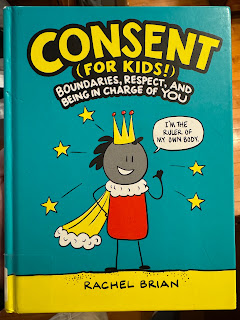Board books to avoid boredom
Learning about board books being a sort of middle ground between toy and book really helped me to understand the medium better. I have always thought that the concept was interesting, but it never quite "clicked" with me, even though I had plenty of board books for my own children. Understanding that board books are meant to be handled just as much, if not more so, than being actually read made a lot of sense. The durability is definitely something that would be beneficial for contact with very young audiences.
The first one I picked was the alphabet-focused book ABCs of Kindness, by Patricia Hegarty, and illustrated by Summer Macon. The copy I looked at is ISBN-13 978-0593123072, published in 2019, by Rodale Kids.
The artwork on the cover immediately struck me as being very cute and welcoming, with soft lines and colors. I immediately assumed it would be very basic, "H is for Hug" type writing. However, when I actually read the book, I discovered that the writing is actually a lot more "grown-up":
The counting book I chose was Fifteen Animals! by Sandra Boynton. The copy in question is ISBN-13 978-0761130666, published in 2008 by Workman Publishing Co. in New York, NY.
Sandra Boynton has always been a favorite author of mine when it comes to children's books, and this is one that has meant a lot to my family. It is one of those books that my kids would have me read over and over, even if it is silly that (almost) all of the animals are named Bob. The book shares a number that counts up as each animal is named. The numbers can be included if you want to focus on the counting aspect, but if there is a time that you don't want to, you don't have to. It's a silly book that I feel helps children to learn about names, about ideas, and about labels in a positive, amusing manner.
Going with Odean's concept of "family chords," my kids and I still jokingly refer to things we don't know the names of as either Bob or Simon James Alexander Ragsdale the Third.
The concept book I chose was Hello, Bugs! by Smriti Prasadam-Halls, and illustrated by Emily Bolam. The copy in question is ISBN-13 978-1589258624, published in 2010 by Tiger Tales in Wilton, CT.
I enjoy the high contrast used on the images in this book. The pictures unfortunately do not do it justice, as each of the colors chosen for each bug outside of the black and white is a reflective metallic foil. It is eye-catching for children as well as adults. The writing is simple, with each bug being introduced with a "Hello, [bug name]!" and a small sound effect onomatopoeia for each.
The repetition is good for children, the ending the book with a "Bye-bye, Butterfly!" helps to message that it is the end of the book. The sound effects can be repeated by both the adult and the child.
The engineered book I chose was Dear Zoo by Rod Campbell. I had access to the 25th anniversary edition, despite the image below showing 30. The edition I used is ISBN-13 978-1416947370
I have always been nervous about interactive books solely because I feel like they don't hold up very well. Going through my own home library from my children's books, I found that most of the interactive books were missing flaps or otherwise damaged. This ties into the above revelation about these board books being a link between toy and book. That's what makes these interactive books being board books make so much sense. They are meant to be handled, to be explored, to be loved.
What I like about this book is it also ties into that repetition, as well as the surprise of what is next. Each animal is introduced with a variation on "they sent me a ..." and the actual animals are unlabeled. This can help children to understand that the image and the word are connected.
Board books are something that I feel are misunderstood by many, including many of those who fancy themselves fans of youth and children's literature. When we come to understand that the book itself is a tool to learn and explore, we can move toward a more productive outlook.
Odean, K. (2008). Great Books for Babies and Toddlers. Ballantine Books.























Comments
Post a Comment